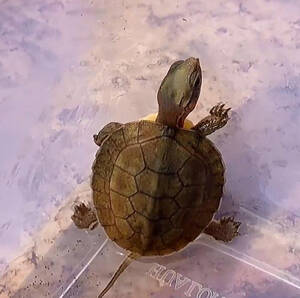Testudines
IUCN
LCBasic Information
Scientific classification
- name:Testudines
- Scientific Name:Tortoise, golden turtle, grass turtle, mud turtle, mountain turtle, black turtle, flower turtle
- Outline:Testudines
- Family:Testudines Pantestudines Testudinata Rhaptochelydia Mesochelydia Perichelydia
Vital signs
- length:9-17cm
- Weight:10-750g
- lifetime:150year
Feature
Turtles have a long lifespan and their shells can be boiled into turtle glue, which is a commonly used Chinese medicine.
Distribution and Habitat
Domestically, it is distributed in Guangdong, Guangxi, Guizhou, Yunnan, Shaanxi, Gansu, Sichuan, Fujian, Hunan, Hubei, Jiangxi, Zhejiang, Jiangsu, Anhui, Henan, Hebei, Shandong, Hong Kong, and Taiwan. Abroad, it is distributed in Japan, North Korea, and South Korea.
It lives in rivers, lakes, rice fields, streams, etc. It is aquatic, omnivorous, and prefers to eat animal food. It can eat when the ambient temperature is around 15℃, and its appetite increases as the ambient temperature rises.
Appearance
Divided into head, neck, body, tail and limbs. The special morphological structure that is significantly different from other reptiles is that it has a turtle shell, and its wide and short body is contained in the turtle shell.
The back of the head is smooth and scaleless, the snout is short, the tip of the snout is beveled downward, the top is not hook-shaped, and the tympanic membrane is obvious. The carapace is oval, nearly oval, flat, with a raised center and three sharp edges. The front edge of the plastron is flat and the rear edge is deeply notched. The limbs are flat and scaly, with scaly spaces between the fingers and toes. The tail is thin and short. The female's head is green-olive, tending to bluish-brown, with yellow-green worm-like and vertical stripes on the side of the head, and yellow-green vertical stripes on the side of the neck.
Details
In a broad sense, turtle refers to the general term for animals of the order Testudinata, and in a narrow sense, refers to species under the family Testudinidae. It is an ancient reptile that still exists. Generally, turtles are also called tortoises. Turtles are reptiles that evolved with shells as the center. Turtles were first seen in the early Triassic period, when fully developed shells were already available. Early turtles may not have been able to retract their heads and limbs into their shells. Turtles have lived on Earth for tens of millions of years, and are animals of the same period as the dinosaurs. Simply put, there are three types of turtles: water turtles, land turtles, and semi-aquatic turtles.
The real turtle is the grass turtle, the adult male of which will turn black, so it is called a turtle. Most turtles are carnivorous, feeding on worms, snails, shrimps, small fish, etc., and also on the stems and leaves of plants.
The characteristic of turtles is that they have very strong shells on their bodies. When attacked, turtles can retract their heads, tails and limbs into their shells (except sea turtles and alligator turtles). Most turtles are aquatic or semi-aquatic, and most are distributed in tropical or near-tropical areas. Many are also found in temperate areas. Some turtles are terrestrial, a few live in the ocean, and the rest live in fresh water. They feed on fresh plants or small animals, or both. They can tolerate fasting for a long time. They usually reproduce once a year. Females lay eggs on land. The eggs are white, round or elongated. Usually, the female turtle digs a hole with her hind legs and lays the eggs in the hole.

How to distinguish male and female turtles: The belly of males is concave, while that of females is flat; males have a strong odor, while females have a lighter odor; there are obvious differences in appearance: males are smaller, while females are larger.
Methods for calculating the age of turtles:
1. Similar to the calculation of tree age by tree rings, the concentric rings on the tortoise shell can determine the age of the turtle, that is, the number of concentric rings on the shield, then add 1 (one ring after hatching), which equals the actual age of the turtle. Wild turtles in southern my country live about 20 years, and turtles in the north live about 40 years.
2. Turtles grow relatively slowly, and the number of concentric rings (growth rings) on the shield of the turtle carapace is used to calculate, and one ring is one year of growth. Of course, different turtle species, ring clarity, and the presence of rings at hatching will also affect the accuracy of age. The life span of turtles is generally long, at least 20 years. According to historical records, the life span of white turtles is more than 800 years, so there is a longevity reputation of "a thousand-year-old turtle and a ten-thousand-year-old turtle".
3. The approximate age can be seen from the lines on the turtle shell. The darker the color and the clearer the lines, the older it is. On the contrary, it is young. If it is the actual age, it is difficult to judge. The method of identifying the age of turtles. It is to look at the lines on the carapace on the back of the turtle, that is, the number of circles. There are circles on each carapace, and the number of circles represents the age. The more circles, the older it is. The method of calculating the age of turtles is generally based on the number of concentric rings on the turtle's carapace shield. Each circle represents a growth cycle, that is, one year. For old turtles or turtles with unclear concentric rings, we can only estimate its approximate age.








